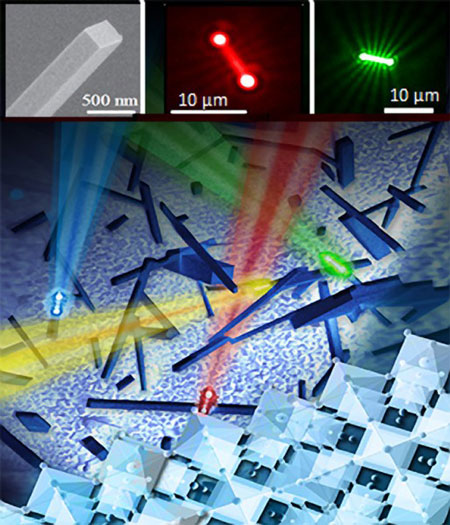| Posted: Jun 17, 2016 |
World's most efficient nanowire lasers
(Nanowerk News) Known for their low cost, simple processing and high efficiency, perovskites are popular materials in solar panel research. Now, researchers demonstrated that nanowires made from lead halide perovskite are the most efficient nanowire lasers known (Nature Materials, "Lead halide perovskite nanowire lasers with low lasing thresholds and high quality factors").
|
 |
| Perovskite-based nanowire lasers are the most efficient known. A topological image of a nanowire is shown (left insert). Room temperature emission images above the lasing threshold for two nanowires composed of different halides, iodide (red in center) and bromide (green on the right), are shown in top inserts. (Image: Xiaoyang Zhu, Columbia University)
|
|
Efficient nanowire lasers could benefit fiber optic communications, pollution characterization, and other applications. The challenge is getting the right material. These ultra-compact wires have a superior ability to emit light, can be tuned to emit different colors, and are relatively easy to synthesize. The development of these perovskite wires parallels the rapid development of the same materials for efficient solar cells.
|
|
Semiconductor nanowire lasers, due to their ultra-compact physical sizes, highly localized coherent output, and efficiency, are promising components for use in fully integrated nanoscale photonic and optoelectronic devices. Lasing requires a minimum (threshold) excitation density, below which little light is emitted. A high “lasing threshold” not only makes critical technical advances difficult, but also imposes fundamental limits on laser performance due to the onset of other losses.
|
|
In searching for an ideal material for nanowire lasing, researchers at Columbia University and the University of Wisconsin-Madison investigated a new class of hybrid organic-inorganic semiconductors, methyl ammonium lead halide perovskites (CH3NH3PbX3), which is emerging as a leading material for high-efficiency photovoltaic solar cells due to low cost, simple processing and high efficiencies.
|
|
The exceptional solar cell performance in these materials can be attributed to the long lifetimes of the carriers that move energy through the systems (electrons and holes) and carrier diffusion lengths. These properties, along with other attributes such as high fluorescence yield and wavelength tunability, also make them ideal for lasing applications. Room temperature lasing in these nanowires was demonstrated with:
|
|
The lowest lasing thresholds and the highest quality factors reported to date
Near 100% quantum yield (ratio of the number of photons emitted to those absorbed)
Broad tunability of emissions covering the near infrared to visible wavelength region.
|
|
Specifically, the laser emission shifts from near infrared to blue with decreasing atomic number of the halides (X=I, Br, Cl) in the nanowires. These nanowires could advance applications in nanophotonics and optoelectronic devices. In particular, lasers that operate in the near infrared region could benefit fiber optic communications and advance pollution characterization from space.
|

